
Silicon carbide coatings enhance aircraft efficiency by enabling engines to operate at higher temperatures. Their hardness, measured at 35 GPa, and elastic modulus of up to 400 GPa ensure structural integrity under extreme conditions. These properties reduce fuel consumption while maintaining durability, making SiC coating a critical innovation in modern aviation.
Key Takeaways
- Silicon carbide coatings make planes lighter, using less fuel and working better.
- These coatings let engines run hotter, making them more efficient and needing fewer coolers.
- Silicon carbide coatings last longer, cutting down on repairs and saving money.
Mechanisms of Silicon Carbide Coatings

Lightweight properties and fuel consumption
Silicon carbide coatings contribute to weight reduction in aircraft components. These coatings replace heavier materials without compromising structural integrity. By reducing the overall weight of the aircraft, they lower the energy required for propulsion. This directly impacts fuel consumption, as lighter aircraft require less fuel to maintain optimal performance. Engineers often apply these coatings to turbine blades and other engine parts, where weight reduction is critical. The lightweight nature of silicon carbide coatings also enhances the aircraft’s range, allowing it to travel longer distances on the same amount of fuel.
Thermal efficiency and heat resistance
Silicon carbide coatings enable engines to operate at higher temperatures by providing exceptional heat resistance. These coatings protect engine components from thermal degradation, ensuring consistent performance under extreme conditions. Higher operating temperatures improve thermal efficiency, which translates to better fuel utilization. The ability of silicon carbide coatings to withstand intense heat also reduces the need for additional cooling systems, further optimizing fuel efficiency. This property makes them indispensable in modern jet engines, where thermal performance is a key factor in overall efficiency.
Durability and maintenance reduction
The durability of silicon carbide coatings minimizes wear and tear on critical components. Their hardness and resistance to corrosion extend the lifespan of engine parts, reducing the frequency of maintenance. This durability not only lowers operational costs but also ensures that engines run efficiently for longer periods. By protecting components from damage, silicon carbide coatings help maintain consistent fuel efficiency throughout the aircraft’s service life. Airlines benefit from fewer disruptions and lower maintenance expenses, making these coatings a cost-effective solution.
Benefits of Silicon Carbide Coatings for Aircraft

Reduced fuel consumption and cost savings
Silicon carbide coatings significantly reduce fuel consumption by improving engine efficiency and lowering aircraft weight. Ceramic matrix composites (CMCs) made with silicon carbide fibers replace traditional metal alloys in jet engines. These materials are lighter than metals but maintain comparable strength. This weight reduction decreases the energy required for propulsion, allowing aircraft to consume less fuel during operation. Additionally, the ability of silicon carbide coatings to withstand higher temperatures enhances engine performance. Engines operating at elevated temperatures achieve better thermal efficiency, which translates to optimized fuel utilization. Airlines benefit from these advancements through reduced operational costs, as less fuel is needed for each flight.
Environmental benefits and lower emissions
The use of silicon carbide coatings contributes to a more sustainable aviation industry by reducing greenhouse gas emissions. Lighter aircraft and more efficient engines burn less fuel, which directly lowers carbon dioxide output. Research shows that engines equipped with silicon carbide-based CMCs operate more efficiently, minimizing their environmental impact. Furthermore, the durability of these coatings reduces the frequency of maintenance and part replacements, decreasing the production and disposal of engine components. This durability supports long-term sustainability by conserving resources and reducing waste. As the aviation industry seeks to meet stricter environmental regulations, silicon carbide coatings play a vital role in achieving these goals.
Broader Applications and Future Potential
Current use in aviation
Silicon carbide coatings have become essential in modern aviation due to their ability to enhance performance in extreme conditions. These coatings are widely applied to jet engine components, such as turbine blades and combustion chambers, where high temperatures and mechanical stress are common. Their heat resistance and durability ensure consistent performance, even during prolonged operation. Aircraft manufacturers also use silicon carbide coatings in sensors that monitor engine conditions. These sensors provide accurate data in high-temperature environments, improving safety and operational efficiency. Beyond engines, silicon carbide coatings contribute to the development of lightweight structural components, further reducing aircraft weight and fuel consumption.
In addition to aviation, these coatings find applications in aerospace and defense. Satellites and missiles benefit from the durability and reliability of silicon carbide coatings, which enhance their performance in harsh environments. This versatility highlights the growing importance of silicon carbide coatings across industries.
Future advancements and innovations
The future of silicon carbide coatings in aviation looks promising, with ongoing research focused on improving their properties and expanding their applications. Scientists are exploring advanced manufacturing techniques, such as additive manufacturing, to create more complex and efficient coated components. These innovations aim to further reduce weight and improve thermal performance. Additionally, the integration of silicon carbide coatings with emerging technologies, such as electric propulsion systems, could revolutionize aircraft design.
Outside aviation, silicon carbide semiconductor devices are gaining traction in power electronics. These devices are used in converters, inverters, and motor control systems, supporting the shift toward electrification and sustainability. As industries prioritize efficiency and environmental responsibility, silicon carbide coatings will play a pivotal role in shaping the future of transportation and energy systems.
Silicon carbide coatings revolutionize aviation by enhancing fuel efficiency through weight reduction, improved thermal performance, and increased durability. These advancements lower operational costs and reduce emissions, supporting a more sustainable industry. As research progresses, this technology will likely redefine aircraft design, enabling even greater efficiency and environmental benefits.
제품 정보
What makes silicon carbide coatings suitable for aviation?
Silicon carbide coatings offer high heat resistance, lightweight properties, and exceptional durability. These features improve engine performance, reduce fuel consumption, and extend component lifespan.
How do silicon carbide coatings reduce maintenance costs?
Their durability minimizes wear and corrosion on engine parts. This reduces the frequency of repairs and replacements, lowering overall maintenance expenses for airlines.
Are silicon carbide coatings environmentally friendly?
Yes, they reduce fuel consumption and emissions by improving engine efficiency. Their longevity also decreases waste from frequent part replacements, supporting sustainable aviation practices.


